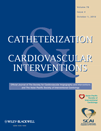Optimal projection estimation for transcatheter aortic valve implantation based on contrast-aortography†
Validation of a Prototype Software
Conflict of interest: The authors of the present manuscript have no relevant disclosures.
Abstract
We investigate the accuracy of a new software system (C-THV, Paieon) designed to calculate the optimal projection (OP) view for transcatheter aortic valve implantation (TAVI) based on two aortograms, and its agreement with the operator's choice. An optimal fluoroscopic working view projection with all three aortic cusps depicted in one line, is crucial during TAVI. In our institution selection of the OP is based on multislice computed tomography (MSCT). Seventy-three consecutive patients referred for TAVI were divided into two groups. For the first group (53 patients, retrospective cohort) we compared the OP views estimated by C-THV with the ones estimated by MSCT. For the second group (20 patients, prospective cohort), we compared the OP views estimated by C-THV with the operator's choice during TAVI. For the retrospective cohort, the mean absolute difference (mean ± SD) between C-THV and MSCT was 6.6 ± 4.9 degrees. In 77% of the cases the mean difference between C-THV and MSCT was <10 degrees. For the prospective cohort, the mean absolute difference (mean ± SD) between C-THV and the operator's choice was 5.5 ± 3.4 degrees. A mean difference of <10 degrees was found in 90% of the cases. In this study we found that the C-THV software estimated the OP view for TAVI with good accuracy. The level of agreement between C-THV and either the MSCT or the operator's choice was deemed satisfactory, with the vast majority of observed differences being <10 degrees. © 2010 Wiley-Liss, Inc.




